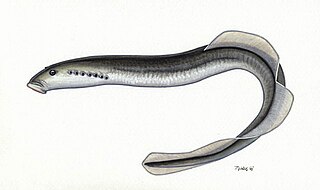
The sea lamprey is a parasitic lamprey native to the Northern Hemisphere. It is sometimes referred to as the "vampire fish".

The brook lamprey is a small European lamprey species that exclusively inhabits freshwater environments. The species is related to, but distinct from, the North American western brook lamprey.

The Arctic lamprey, also known as the Japanese river lamprey or Japanese lampern, is a species of lamprey, a jawless fish in the order Petromyzontiformes. It inhabits coastal freshwater habitat types in the Arctic. Some populations are anadromous, spending part of their lives in the ocean. It is the most common and widespread lamprey in the Arctic region.

The Pacific lamprey is an anadromous parasitic lamprey from the Pacific Coast of North America and Asia. It is a member of the Petromyzontidae family. The Pacific lamprey is also known as the three-tooth lamprey and tridentate lamprey.

The European river lamprey, also known as the river lamprey or lampern, is a species of freshwater lamprey.

The Western brook lamprey is a small, widely distributed, non-parasitic species of jawless fish endemic to the freshwater coastal waterways of the Western United states and Canada. Its range extends from the North American Pacific coast from Taku River, southern Alaska, Queen Charlotte Islands, to central California, including Vancouver Island, with major inland distributions in the Columbia and Sacramento-San Joaquin watersheds.

The Florida gar is a species of gar found in the US from the Savannah River and Ochlockonee River watersheds of Georgia and throughout peninsular Florida. Florida gar can reach a length over 3 ft (91 cm). The young feed on zooplankton and insect larvae, as well as small fish. Adults mainly eat fish, shrimp, and crayfish. Although edible, they are not popular as food. The roe is highly toxic to many animals, including humans and birds. Florida Gar are mentioned in the John Anderson song "Seminole Wind".

The chestnut lamprey is a species of lamprey.

Lethenteron appendix, the American brook lamprey, is a common non-parasitic lamprey in North America. In adults their disc-like mouths contain poorly developed teeth, useless for attaching to a host.
The silver lamprey is a lamprey commonly found in the Northern and Central United States, as well as a large part of southern Canada. Its binomial name means "sucking fish" in Greek and "one-pointed" in Latin. The silver lamprey is a member of the Class Agnatha, sometimes referred to as cyclostomes (round-mouths). Other common names include: Bloodsucker, Blue Lamprey, Hitch-hiker, Lamper, Lamprey Eel. The silver lamprey should not to be confused with the sea lamprey, which has caused considerable damage to native fish populations in the Great Lakes region.
The mountain brook lamprey or Allegheny brook lamprey is a lamprey found in parts of the Mississippi river basin, New York, Pennsylvania, Ohio, and in the Cumberland River and Tennessee River. This fish is jawless with a small sucker mouth and a long, eel-like body. It is fairly small, only growing to about 8 inches (20 cm) in length.

The northern brook lamprey is a freshwater fish in the family Petromyzontidae. It is closely related to the silver lamprey and may represent an ecotype of a single species with I. unicuspis.

Eudontomyzon danfordi, the Carpathian brook lamprey or Danube lamprey, is a species of lamprey in the family Petromyzontidae. It is found in Austria, Bosnia and Herzegovina, Bulgaria, Croatia, Czech Republic, Hungary, Moldova, Romania, Serbia, Montenegro, Slovakia, and Ukraine. It is non-parasitic.

The Ukrainian brook lamprey is a species of lamprey in the Petromyzontidae family. It is found in brackish and freshwater areas in Austria, Belarus, Bulgaria, the Czech Republic, Georgia, Hungary, Moldova, North Macedonia, Poland, Romania, Russia, Serbia and Montenegro, Slovakia, Turkey, and Ukraine. It invaded the basin of the Volga River in 2001.
The Kern brook lamprey is a species of lamprey in the Petromyzontidae family endemic to the United States. It is found on the east side of San Joaquin Valley, in lower Merced, Kaweah, Kings, and San Joaquin rivers in California. It can grow to up to around 14 centimeters, and is characterized by its grayish brown and white coloring, and black spots on its fins.

Lampreys are an ancient extant lineage of jawless fish of the order Petromyzontiformes, placed in the superclass Cyclostomata. The adult lamprey may be characterized by a toothed, funnel-like sucking mouth. The common name "lamprey" is probably derived from Latin lampetra, which may mean "stone licker", though the etymology is uncertain. Lamprey is sometimes seen for the plural form.
The Caspian lamprey, Caspiomyzon wagneri, is a species of lamprey native to the Caspian Sea, and a member of the Petromyzontidae family. Eudontomyzon hellenicus and E. graecus also possibly belong in this genus. This species is a non-parasitic lamprey that feeds on animal carcasses.
The least brook lamprey is a common, non-parasitic lamprey distributed in the Mississippi River watershed, and a limited range along the Atlantic coast.
The Ohio lamprey is a lamprey found in the Ohio River drainage basin in the United States and is a parasitic species of lampreys. They are considered to be an endangered/rare species in some states, due to siltation, pollution, and construction of dams.

Lampetra ayresii is a species of lamprey in the family Petromyzontidae. It is also called the river lamprey or western river lamprey. It is found in the eastern Pacific, specifically from Tee Harbor, Juneau in Alaska to the Sacramento–San Joaquin drainage in California, USA. It can survive in both marine surface waters and freshwater lakes, rivers, and creeks. In freshwater, it is found typically in the lower portions of large river systems. It is a predatory fish and feeds on fishes in the size range of 10–30 cm. It feeds by attaching to prey using its round, sucker-like mouth. Adult western river lampreys typically grow to about 21 cm (8.3 in) total length (TL), but can reach 31 cm (12 in) TL.















